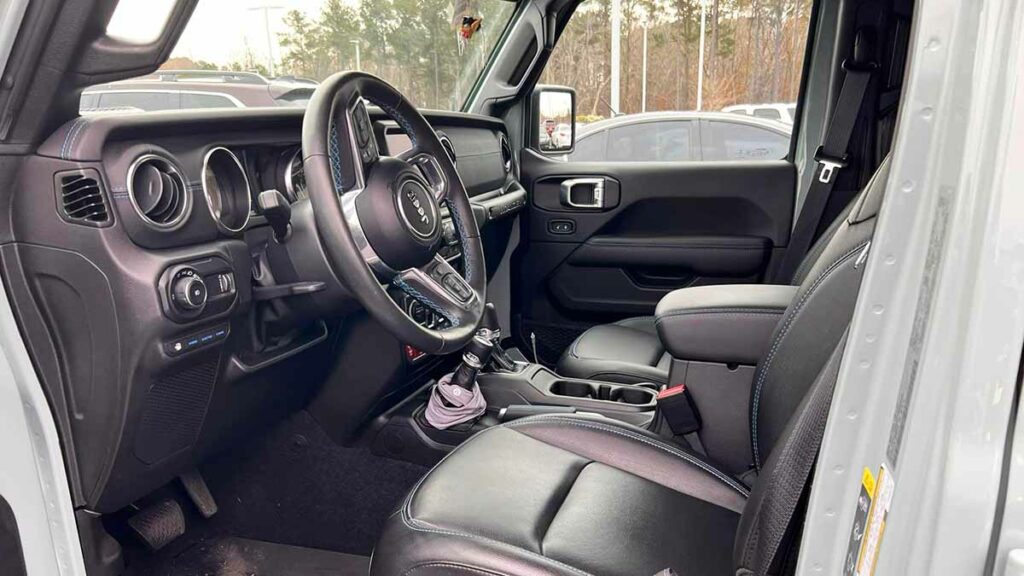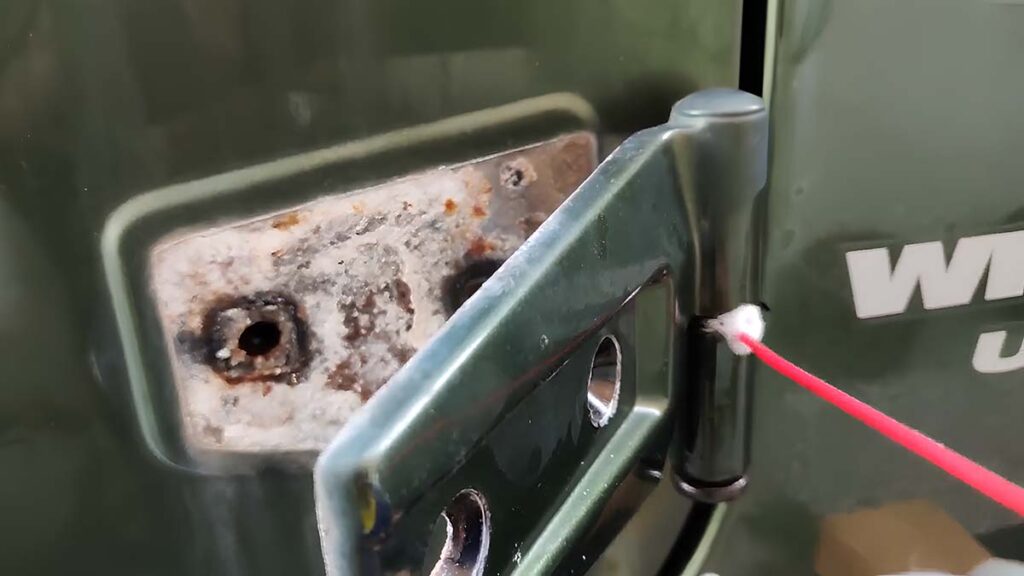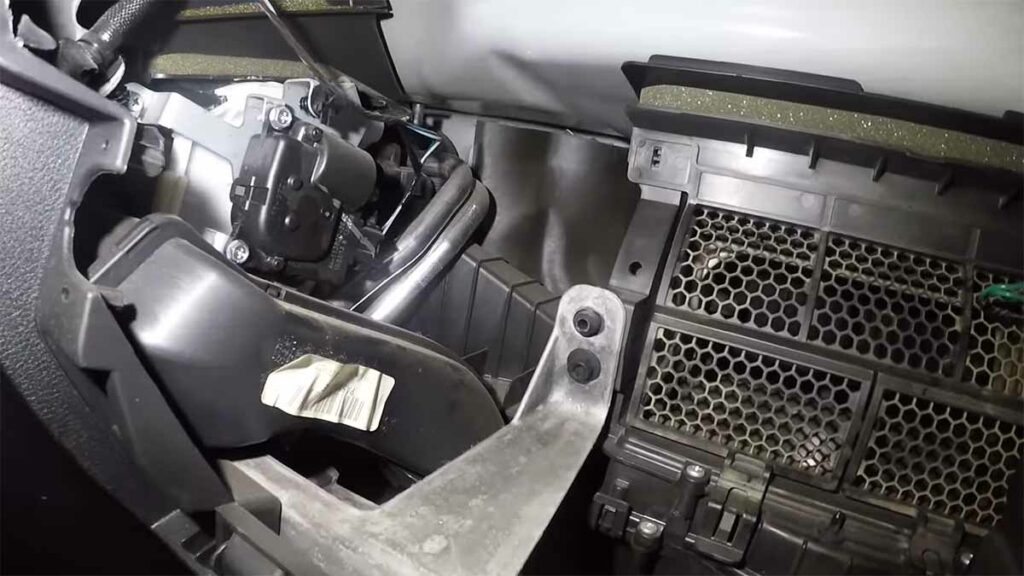Jeep Makes Clicking Noise When Opening The Door – Why? What To Do?
When you swing open the door of your Jeep, ready for a new adventure, you may notice a clicking sound that wasn’t there before. It’s a bit puzzling, right?
When opening a Jeep’s door, the clicking sound may stem from issues with the door latch, worn hinges, misaligned striker plate, or problems with the blend door actuator.

I will explain the mystery of the “clicking noise when opening the Jeep door” in this article. You’ll figure out why this sound happens and what you can do about it.
Table of Contents
Why Does My Jeep Make a Clicking Noise When Opening the Door? How Do I Fix It?
The clicking noise your Jeep makes when opening the door can originate from two sources.
- The door itself
- From the dashboard
Clicking Noise When Opening the Door
If you’re hearing a clicking sound when opening and closing your Jeep’s driver’s door, start by inspecting the door latch for any signs of looseness or damage.
A faulty latch can result in a clicking noise and may need replacement.
Similarly, worn-out or damaged hinges can contribute to this problem. Examine the hinges thoroughly to determine if they require replacement.
Occasional maintenance of door hinges is crucial. Wipe the hinge area with a clean rag and apply white lithium grease or a few drops of motor oil.
Wipe away the excess grease to prevent debris buildup.

The clicking may also originate from the seam where the door is glued, not the hinge.
The adhesive holding parts of the door together may be giving way, causing the clicking. Lubricating the area may offer a temporary solution.
Unfortunately, the most comprehensive solution identified so far is door replacement. However, even this drastic measure may not guarantee a permanent fix, as the inherent design flaw persists in newer models.
You may find issues related to the exterior frame.
The outer door frame may flex or rub against the interior frame, creating clicking sounds.
A temporary solution involves strategically using electrical tape between seams on the corner where the frame flexes.
While this may not be a permanent fix, it provides a simple and accessible remedy until a more extensive solution is found.
One common culprit is insufficient lubrication in the door check mechanism.
Over time, the mating surfaces of the check guide can become tight, leading to clicking sounds.
Consider using an industrial-grade lubricant suitable for plastics and other materials.
Ensure thorough application on the outer door frame where the check enters the side of the door.
The inside of the door, where the door control arm is attached, can also be the source of the clicking. This area may have adhesive holding parts together, and the clicking can result from the adhesive releasing as the door moves.
While spraying lubricant may help, the clicking may persist in the long run. Releasing the arm and pushing it through the door is another option.
Clicking noise may be caused by wear in bracket holes and check arms.
If the holes become oval-shaped due to prolonged use, the arm’s spring mechanism may snap quickly, causing the sound.
To address this issue, consider replacing worn-out parts or using correctly sized roll pins.
For those with persistent clicking after door check replacement, internal components within the door, such as the detent link or hinge pins, may contribute to the issue.
Ensure these parts are inspected for wear and tear. A defective door detent link or worn hinge pins can be the noise source.
Another potential source of clicking stems from the door position stop bolt for those who take the door off and reinstall.
Improper reinstallation may lead to a retracted door position stopping at an awkward angle, causing clicking.
Ensuring that this bolt is securely tightened and verifying the tightness of all bolts after any maintenance or removal is a fundamental step in addressing potential sources of clicking.
Another component to check is the striker plate, which catches the door when closed.
If the striker plate is misaligned, it can lead to a clicking noise when opening the door. Depending on the severity of the issue, adjustment or replacement of the striker plate may be necessary.
Sometimes, the inner parts of the door delaminate and rub against each other.
Unfortunately, the only solution to this problem and many others is to replace the door.
However, it’s not an easy fix as it involves color matching.
You can have your doors replaced if you’re under warranty, but the issue may reappear after some time as this issue continues in the next model of Jeeps.
Clicking Noise Behind the Glove Box
Moving beyond door-related noises, if you hear clicks under the dashboard of your Jeep, especially during HVAC system operations, there may be an issue with the heating and cooling system components.
The clicking sound is often associated with the actuator under the dashboard.
To identify the source of the clicking, consider the following steps:
Continuous Clicking Sound
If you’re driving a Jeep and experiencing a fast, loud clicking noise when opening the driver’s side front door, it can be related to the HVAC system.
This issue can be associated with the blend door actuator, which has small plastic gears that may strip over time, leading to clicking sounds.

Testing HVAC Controls
Turn your air conditioner or heater on and off. If the clicking noise corresponds to the activation of these controls, it likely involves the heating and cooling systems.
Loud Tapping
A louder and more repetitive tapping sound may indicate an issue with the blend door actuator.
While this noise may subside after a minute or by turning off the air conditioner, it indicates a problem within the HVAC system.
If you encounter these dashboard-related clicking issues, you need to replace the blend door actuator.
Consider the following actions:
- If the clicking occurs during HVAC system operation, turning off the air conditioner or heater may temporarily alleviate the noise.
- Identify the actuator’s position on the HVAC housing. It’s usually mounted near the heater core or evaporator core.
- Disconnect the vehicle’s battery.
- Depending on your vehicle model, you may need to remove specific panels or components of the dashboard to access the blend door actuator.
- Carefully pry and remove these panels.
- Once you’ve exposed the HVAC housing, locate the faulty blend door actuator.
- It’s typically a small, rectangular, or cylindrical component with an electrical connector.
- Disconnect the electrical connector attached to the actuator. Be gentle to avoid damaging the wiring.
- Unfasten the mounting screws or bolts securing the actuator. Keep track of these fasteners for reinstallation.
- Install the new blend door actuator. Secure it using the previously removed screws or bolts.
- Attach the electrical connector to the new actuator securely.
- Reconnect the vehicle’s battery and start the engine. Test the HVAC system to ensure the new blend door actuator operates properly.
- Put back any dashboard panels or components you removed earlier, ensuring a proper fit.
If you’re unfamiliar with the system, check out this video for more visual guidelines.
Read More:
- Active Lane Management Unavailable Service Required: 9 Major Causes And Their Fixes
- Vehicle Not In Park Message: 7 Major Causes and Fixes
Final Words
Addressing the clicking noise when opening a Jeep’s door requires thoroughly investigating potential causes.
Whether it’s a loose or damaged door latch, worn-out hinges, misaligned striker plate, or issues within the heating and cooling system, understand the root of the problem.
Regular maintenance checks and prompt attention to emerging sounds can contribute to a quieter and more enjoyable driving experience.
If the clicking persists, seek professional assistance to ensure a comprehensive inspection and appropriate repairs, allowing you to enjoy smooth door operation without noise disturbances.
